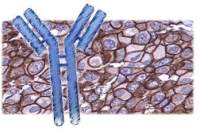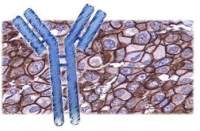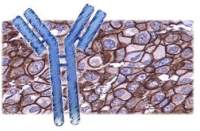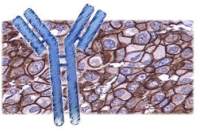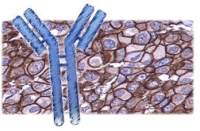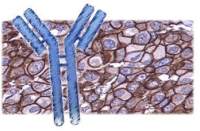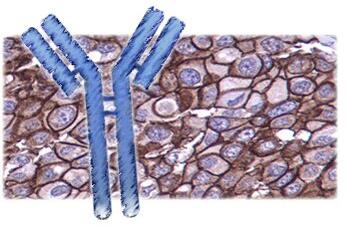
产品详情
文献和实验
相关推荐
供应商 :上海联迈生物工程有限公司
库存 :大量
靶点 :详见说明书
级别 :1
目录编号 :LM-1708R-FITC
克隆性 :多克隆
抗原来源 :Rabbit
保质期 :1年
抗体英文名 :Anti-CD45RO/FITC
抗体名 :Anti-CD45RO/FITC
标记物 :FITC标记
宿主 :Human, Mouse, Rat,
适应物种 :Human, Mouse, Rat,
免疫原 :详见说明书
亚型 :IGg
形态 :粉末、液体、冻干粉
应用范围 :Flow-Cyt=1:50-200 IF=1:50-200
浓度 :1mg/ml
保存条件 :-20 °C
规格 :100ul
FITC标记的CD45RO抗体| 英文名称 | Anti-CD45RO/FITC |
| 中文名称 | FITC标记的CD45RO抗体 |
| 别 名 | B220; CD 45; CD45; cd45 antigen; ec3.1.3.48; CD45R; GP180; GP180; GP 180; L CA; LCA; L-CA; Leukocyte common antigen; LY5; Protein tyrosine phosphatase receptor type C; Protein tyrosine phosphatase receptor type c polypeptide; protein tyrosine phosphatase, receptor type, C; Receptor-type tyrosine-protein phosphatase C; PTPRC; PTPRC_HUMAN; SCID due to PTPRC deficiency; T200; T200 glycoprotein; T200 leukocyte common antigen; Human homolog of severe combined immunodeficiency due to PTPRC deficiency. |
| 规格价格 | 100ul/2980元 购买 大包装/询价 |
| 说 明 书 | 100ul |
| 研究领域 | 细胞生物 神经生物学 干细胞 细胞膜受体 细胞表面分子 糖蛋白 细胞类型标志物 自然杀伤细胞 淋巴细胞 t-淋巴细胞 b-淋巴细胞 |
| 抗体来源 | Rabbit |
| 克隆类型 | Polyclonal |
| 交叉反应 | Human, Mouse, Rat, |
| 产品应用 | Flow-Cyt=1:50-200 IF=1:50-200 not yet tested in other applications. optimal dilutions/concentrations should be determined by the end user. |
| 分 子 量 | 180kDa |
| 细胞定位 | 细胞膜 |
| 性 状 | Lyophilized or Liquid |
| 浓 度 | 1mg/ml |
| 免 疫 原 | Cultured T cells from an IL-2-dependent T-cell line (CA1) prepared from human peripheral blood activated with influenza virus. |
| 亚 型 | IgG |
| 纯化方法 | affinity purified by Protein A |
| 储 存 液 | 0.01M TBS(pH7.4) with 1% BSA, 0.03% Proclin300 and 50% Glycerol. |
| 保存条件 | Store at -20 °C for one year. Avoid repeated freeze/thaw cycles. The lyophilized antibody is stable at room temperature for at least one month and for greater than a year when kept at -20°C. When reconstituted in sterile pH 7.4 0.01M PBS or diluent of antibody the antibody is stable for at least two weeks at 2-4 °C. |
| 产品介绍 | background: CD45RO is a single chain transmembraneous glycoprotein which represents the low molecular weight isoform of the Leucocyte Common Antigen (LCA). It is expressed on most thymocytes, about 45% of peripheral blood T cells, virtually all T cells in skin reactive infiltrates, and the majority of T cell malignancies. It is also found on a subset of B cells and on exceptional B cell lymphomas. CD45 is a family of single chain transmembraneous glycoproteins consisting of at least four isoforms (220, 205, 190, 180 kDa) which share a common large intracellular domain. Their extracellular domains are heavily glycosylated. The different isoforms are produced by alternative messenger RNA splicing of three exons of a single gene on chromosome 1. CD45 is expressed on cells of the human hematopoietic lineage (including hematopoietic stem cells) with the exception of mature red cells. It is not detected on differentiated cells of other tissues. It is likely that CD45 plays an important role in signal transduction, inhibition or upregulation of various immunological functions. Antibodies recognising a common epitope on all of the isoforms are termed CD45 whilst those recognising only individual isoforms are termed CD45RA or CD45RO etc. Function: Protein tyrosine-protein phosphatase required for T-cell activation through the antigen receptor. Acts as a positive regulator of T-cell coactivation upon binding to DPP4. The first PTPase domain has enzymatic activity, while the second one seems to affect the substrate specificity of the first one. Upon T-cell activation, recruits and dephosphorylates SKAP1 and FYN. Dephosphorylates LYN, and thereby modulates LYN activity. Subunit: Binds GANAB and PRKCSH. Interacts with SKAP1. Interacts with DPP4; the interaction is enhanced in a interleukin-12-dependent manner in activated lymphocytes. Subcellular Location: Membrane; Single-pass type I membrane protein. Membrane raft. Note=Colocalized with DPP4 in membrane rafts. Post-translational modifications: Heavily N- and O-glycosylated. DISEASE: Defects in PTPRC are a cause of severe combined immunodeficiency autosomal recessive T-cell-negative/B-cell-positive/NK-cell-positive (T(-)B(+)NK(+) SCID) [MIM:608971]. A form of severe combined immunodeficiency (SCID), a genetically and clinically heterogeneous group of rare congenital disorders characterized by impairment of both humoral and cell-mediated immunity, leukopenia, and low or absent antibody levels. Patients present in infancy recurrent, persistent infections by opportunistic organisms. The common characteristic of all types of SCID is absence of T-cell-mediated cellular immunity due to a defect in T-cell development. Genetic variations in PTPRC are involved in multiple sclerosis susceptibility (MS) [MIM:126200]. MS is a neurodegenerative disorder characterized by the gradual accumulation of focal plaques of demyelination particularly in the periventricular areas of the brain. Peripheral nerves are not affected. Onset usually in third or fourth decade with intermittent progression over an extended period. The cause is still uncertain. Similarity: Belongs to the protein-tyrosine phosphatase family. Receptor class 1/6 subfamily. Contains 2 fibronectin type-III domains. Contains 2 tyrosine-protein phosphatase domains. Database links: Entrez Gene: 5788 Human Entrez Gene: 19264 Mouse Omim: 151460 Human SwissProt: P08575 Human SwissProt: P06800 Mouse Unigene: 654514 Human Unigene: 391573 Mouse Important Note: This product as supplied is intended for research use only, not for use in human, therapeutic or diagnostic applications. |

上海联迈生物工程有限公司
品牌商实名认证
钻石会员
入驻年限:8年

